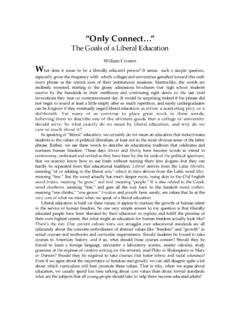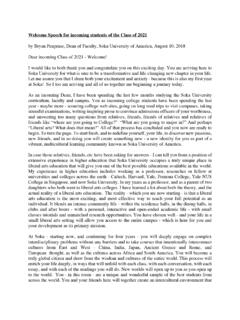Transcription of What is the Meaning and Purpose of Supervision?
1 1 What is the Meaning and Purpose of Supervision? This chapter provides an orientation to the landscape of supervision by providing an overview of its historical development within the counselling and psychotherapy tradi-tion. It will also discuss the Purpose and functions of supervision as articulated in a number of existing definitions. What is Supervision? Beginning trainees bring many questions to supervision , most notably: What is supervision ? Why is it necessary? and What happens in supervision ? They are essential, reflective practice questions and, in many ways, remain a focus of enquiry throughout the career lifespan. As the supervision conversation continues to develop through practice and research, new ideas emerge and new ways of working are pre-sented.
2 As I have developed as a practitioner, the type of supervision I have sought has also developed from formative to consultative supervision as I focus on the broad context of my work. As suggested by Stoltenberg (2005: 858), the path toward profi-ciency is developmental. Different learning needs emerge as supervisees gain knowl-edge and capability (Stoltenberg and McNeill, 1997). It may also be developmental for supervisors as they gain knowledge and clinical wisdom. It is challenging to define supervision . It has different meanings in different contexts. For example, from a professional perspective, in counselling and therapy training it is an integral part of the training process and embedded in that context.
3 It is supported by formal teaching and, frequently, personal therapy. In this context, it is most clearly evaluative, as trainee competence development is keenly monitored in client work. Post-training, as a counsellor or therapist works towards accreditation or registration, while there is more autonomy, supervision is still evaluative. Post-accreditation/registration, and as supervision is usually a career- long requirement, there is a shift towards more 421-Nov-13 9:47:54 AM5 The Meaning and Purpose of Supervisionconsultation and less evaluation. Nevertheless, the element of overseeing is always pre-sent. However, to present supervision in these terms only does not do justice to the supervision phenomenon.
4 It does not capture the essence of the interpersonal supervi-sory relationship. Nor does it speak to the experience of the learning process that is at the heart of supervision and how that occurs in relation to the vicissitudes of that experi-ence. The following section demonstrates the complexity of the supervision endeavour and presents some of the attempts to capture the Meaning and Purpose of supervision . In answer to the question What is supervision ? from a professional practice per-spective, the British Association for Counselling and Psychotherapy (BACP, 2008) pro-vides the following explanation: supervision is a formal arrangement for therapists to discuss their work regularly with someone who is experienced in both therapy and supervision .
5 The task is to work together to ensure and develop the efficacy of the therapist/client relationship. The agenda will be the therapy and feeling about that work, together with the supervisor s reactions, comments and challenges. Thus supervision is a process to maintain ade-quate standards of therapy and a method of consultancy to widen the horizons of an experienced British Psychological Society (BPS) Division of Counselling Psychology, in their Guidelines for supervision (BPS, 2007: 4), also provide a useful definition and frame to reflect on the complexities of supervision when they describe it as an activity , a process , a relationship and a practice . As described by the BPS, it is a professional and ethical activity for reflection on the work that allows for playful reflection for the purposes of future action and is distinct from therapy.
6 supervision is a process of ongoing collabora-tive, experiential and transformational learning that draws on practice and research-based knowledge. It is a flexible relationship of mutual trust, respect and integrity that takes into account the learning needs of the supervisee. Finally, it is a practice that is bounded by an explicit contract and draws on shared and explicit models of supervision (BPS, 2007: 40). The Meaning of supervision and how it is implemented in counselling and psycho-therapy have evolved significantly over many decades, but the key Purpose has remained relatively constant. In essence, supervision exists to facilitate the professional develop-ment of the supervisee at whatever their level of experience with a view to enhancing therapy outcomes with their clients (Ellis and Ladany, 1997).
7 To understand the mean-ing and Purpose of supervision , it is necessary to consider how it has evolved historically in the field and to review the dominant definitions that have developed in an attempt to elucidate the Meaning and Purpose of supervision in counselling and psychotherapy. Historical Overview of SupervisionThe concept of supervision has existed almost as long as the therapy profession itself. The development of supervision within psychotherapy can be more or less charted against 521-Nov-13 9:47:54 AM6 Getting the Best Out of Supervisiondevelopments in psychotherapy theory and practice (Leddick and Bernard, 1980). With its roots in the apprenticeship model, wherein the master passed on their knowledge and skill to the apprentice, as soon as therapists began to provide training to other therapists, supervision frameworks began to emerge within therapy traditions (Leddick, 1994).
8 The development of supervision is chronicled by Carroll (2007: 34), who highlights three stages in the development of supervision occurring broadly within three timeframes, namely: (1) the 1920s and the foundations of the psychoanalytic tradition; (2) the 1950s and the emergence of the humanistic/existential and cognitive-behavioural schools; and (3) the 1970s when supervision began to emerge as a learning activity rather than a counselling activity. The foundation of the Berlin Institute in the 1920s heralded the emergence of supervi-sion in this context (Leddick and Bernard, 1980; Bernard, 2006; Carroll, 2007). Freud has been acknowledged as the first supervisor (Frawley-O Dea and Sarnat, 2001: 17) within psychotherapy, a point contested by Milne (2009), who suggests that the apprenticeship model has been in existence for centuries and that the origins of supervision may perhaps be traced back to the ancient Greeks at the very least!
9 As psychoanalytic training devel-oped, so too did the concept of supervision , or control analysis as it was termed, which sought to maintain the purity of the approach (Moncayo, 2006). It was in the 1930s that the teach or treat controversy arose, and it remains a point of discussion to this day. Bernard and Goodyear (2009: 82) identify Ekstein and Wallerstein (1958) as the first proponents of a psychodynamic supervision model that portrayed supervision as a teaching and learn-ing process which placed emphasis on the teaching rather than the analytic treatment of the supervisee. Against a backdrop of social, cultural, economic and political events, the 1950s were a fertile time in the development of the psychotherapy profession and, consequently, saw the second stage of the development of supervision .
10 The most notable development that culminated during this period was the emergence of the humanistic, existential and cog-nitive behavioural schools, most evidently captured in the iconic film Three Approaches to Psychotherapy (1965), more affectionately referred to as the Gloria film, produced by Shostrom, which demonstrated the respective therapeutic approaches of Carl Rogers (person-centred therapy), Albert Ellis (rational emotive behavioural therapy) and Fritz Perls (Gestalt). Carroll (2007: 34) refers to supervision during this period as being counselling-bound or psychotherapy-bound supervision wherein the principles of the therapeutic approach are applied to the practice of supervision . By the mid-1960s, according to Leddick and Bernard (1980: 190), the field of supervision had three major models: dynamic, facilitative, and behavioural.



















